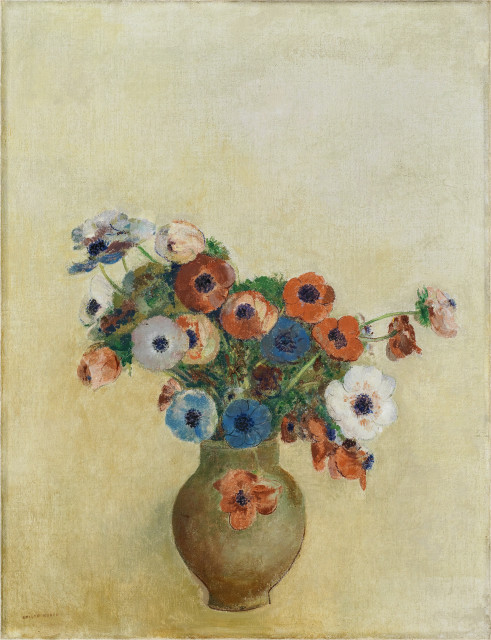- EN
Log in
- Live Auctions
- Past auctions
- More
- Gallery
- Art Dealing
- Publishing
- Kornfeld today
- The Story of Kornfeld
- Information



Bordeaux 1840 - 1916 Paris
1910
Oil on canvas
65,1x50,2 cm
Signed by the artist "Odilon Redon" in red-brown oil paint at lower left
Alec Wildenstein, Odilon Redon, Catalogue raisonné de l'œuvre peint et dessiné, Volume III, Paris 1996, no. 1576
Armand Parent, Paris, ca. 1920
Zaidee C. Goodyear, Virginia
Cornelius Newton Bliss III, Darlington
Mrs. Cornelius N. Bliss, New York, ca. 1928; by inheritance to
private collection, New York
Auction Sotheby's, New York, 13.11.1997, Cat. No. 241; acquired there by
International Private Collection
Paris 1920, Galerie Barbazanges, Exposition rétrospective d'œuvres d'Odilon Redon (1840-1916), cat. no. 92
Paris 1923, Galerie Druet, Exposition d'œuvres d'Odilon Redon, peintures, pastels, aquarelles, dessins, lithographies, eaux-fortes, art décoratif, cat. no. 40, verso with label
New York 1928, De Hauke and Co., Exhibition of Paintings, Pastels, Drawings, Watercolours, Lithographs by Odilon Redon, cat. no. 17
Chicago 1928/1929, The Art Institute of Chicago, Catalogue of Paintings, Pastels and Drawings by Odilon Redon (1840-1916), cat. no. 2
New York 1933, Museum of Modern Art, Exhibition of Fruit and Flower Paintings
On the old chassis. The canvas backed with a thin gauze. Freshly coloured and in perfect condition, framed
As early as the 1860s, Redon was occupied with botanical themes; but it was only when he overcame his "black phase" ("noirs") that colours and, with the colours after the turn of the century, vegetation and flowers once again became the focus of his interest. In addition to the mythologically charged themes, his flower still lifes were particularly sought-after collector's items; and in 1905, for example, his friend and patron Arthur Fontaine noticed how difficult it was to acquire such a flower piece. And the French poet Francis Jammes said that Redon's studio could be compared to a "wonderful garden" in which one could literally smell the scent of each petal
Redon was fascinated by a naturalistic and at the same time free interpretation of his still lifes and clearly preferred certain types of flowers. Thus the "eye-like" anemone was one of his "favourites". Alec Wildenstein aptly wrote "Anémones de nouveau, anemones toujours, fleurs aimées de Redon" ("And again anemones, always anemones, beloved flowers of Redon") about the painting in question. To heighten the visual "sensation", the artist usually placed these still lifes in simple vases, quasi "floating" in front of a neutral background, which can be clearly read in the tradition of Japanese woodblock prints. With his fine style of painting in oil or the often used pastel, Redon impressively succeeds in dissolving naturalism in the direction of abstraction
The painting "Anémones" offered here can look back on an excellent provenance and an early, rich exhibition history. The first owner was the Belgian musician and composer Armand Parent, who was friends with many visual artists of his time. Afterwards the painting was in American private collections for a very long time. Such beautiful and well documented paintings by Redon are very rare today
1910
Öl auf Leinwand
65,1x50,2 cm
Unten links vom Künstler in Pinsel im rot-brauner Ölfarbe signiert "Odilon Redon"
Alec Wildenstein, Odilon Redon, Catalogue raisonné de l'œuvre peint et dessiné, Volume III, Paris 1996,
Armand Parent, Paris, ca. 1920
Zaidee C. Goodyear, Virginia
Cornelius Newton Bliss III, Darlington
Mrs Cornelius N. Bliss, New York, ca. 1928; durch Erbschaft an
Privatsammlung, New York
Auktion Sotheby’s, New York, 13.11.1997,
Internationale Privatsammlung
Paris 1920, Galerie Barbazanges, Exposition rétrospective d'œuvres d'Odilon Redon (1840-1916),
Paris 1923, Galerie Druet, Exposition d'œuvres d'Odilon Redon, peintures, pastels, aquarelles, dessins, lithographies, eaux-fortes, art décoratif,
New York 1928, De Hauke and Co., Exhibition of Paintings, Pastels, Drawings, Watercolours, Lithographs by Odilon Redon,
Chicago 1928/1929, The Art Institute of Chicago, Catalogue of Paintings, Pastels and Drawings by Odilon Redon (1840-1916),
New York 1933, Museum of Modern Art, Exhibition of Fruit and Flower Paintings
Auf dem alten Chassis. Die Leinwand mit einer dünnen Gaze hinterlegt. Farbfrisch und in tadelloser Erhaltung, gerahmt
Bereits in den 1860er Jahren beschäftigte sich Redon mit botanischen Themen; doch erst mit der Überwindung seiner “schwarzen Phase” (“Noirs”), rückten Farben und mit den Farben nach der Jahrhundertwende auch wieder die Vegetation und Blumen in den Fokus seines Interesses. Neben den mythologisch aufgeladenen Themen waren gerade seine Blumenstillleben begehrte Sammlerstücke; und so bemerkte etwa sein Freund und Förderer Arthur Fontaine 1905, wie schwierig es sei, ein solches Blumenstück zu erwerben. Und der französische Dichter Francis Jammes äusserte sich, dass man Redons Atelier mit einem “wunderbaren Garten” vergleichen könne, in welchem man den Duft eines jeden Blütenblattes förmlich riechen könne
Redon war fasziniert von einer naturalistischen und zugleich freien Umsetzung seiner Stillleben und bevorzugte dazu ganz klar gewisse Blumenarten. So gehörte die “augenähnliche” Anemone zu seinen “Favoritinnen”. Alec Wildenstein schrieb zum hier vorliegenden Gemälde treffend “Anémones de nouveau, anemones toujours, fleurs aimées de Redon” (“Und wieder Anemonen, immer Anemonen, geliebte Blumen von Redon”). Um die visuelle “Sensation” zu erhöhen, platzierte der Künstler diese Stillleben meist in schlichten Vasen quasi “schwebend” vor einen neutralen Hintergrund, was klar in der Tradition japanischer Holzschnitte gelesen werden kann. Mit seiner feinen Malweise in Öl oder dem oft auch verwendeten Pastell gelingt es Redon eindrücklich, den Naturalismus in Richtung einer Abstraktion aufzulösen
Das hier angebotene Gemälde “Anémones” kann auf eine ausgezeichnete Provenienz und eine frühe, reiche Ausstellungsgeschichte zurückblicken. Erster Besitzer war der belgische Musiker und Komponist Armand Parent, der mit vielen bildenden Künstlern seiner Zeit befreundet war. Danach hat sich das Gemälde für sehr lange Zeit in amerikanischen Privatsammlungen befunden. So schöne und gut dokumentierte Gemälde von Redon sind heute sehr rar




